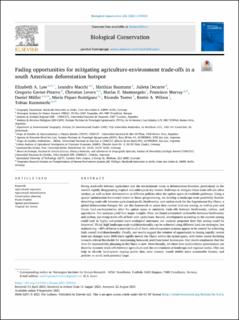Fading opportunities for mitigating agriculture-environment trade-offs in a south American deforestation hotspot
Law, Elizabeth; Macchi, Leandro; Baumann, Matthias; Decarre, Julieta; Gavier-Pizarro, Gregorio; Levers, Christian; Mastrangelo, Matías E.; Murray, Francisco; Müller, Daniel; Piquer-Rodríguez, María; Torres, Ricardo; Wilson, Kerrie A.; Kuemmerle, Tobias
Peer reviewed, Journal article
Published version

Åpne
Permanent lenke
https://hdl.handle.net/11250/2987669Utgivelsesdato
2021Metadata
Vis full innførselSamlinger
- Publikasjoner fra CRIStin - NINA [2397]
- Scientific publications [1423]
Sammendrag
Strong trade-offs between agriculture and the environment occur in deforestation frontiers, particularly in the world's rapidly disappearing tropical and subtropical dry forests. Pathways to mitigate these trade-offs are often unclear, as well as how deforestation or different policies alter the option space of available pathways. Using a spatial optimization framework based on linear programming, we develop a landscape-scale possibility frontier describing trade-offs between agricultural profit, biodiversity, and carbon stock for the Argentinean Dry Chaco, a global deforestation hotspot. We use this framework to assess how current land-use zoning, as well as past and future land-use-trajectories, alter the option space to minimize trade-offs between biodiversity, carbon, and agriculture. Our analyses yield four major insights. First, we found substantial co-benefits between biodiversity and carbon, yet strong trade-offs of both with agriculture. Second, development according to the current zoning could lead to highly suboptimal socio-ecological outcomes; our analysis pinpoints how this zoning could be improved. Third, high landscape-scale multifunctionality can be achieved using different land-use strategies, but maintaining >40% of forest is essential in all of them, and silvopasture systems appear to be central for achieving high overall multifunctionality. Finally, our results suggest the window of opportunity is closing rapidly: recent land-use changes since 2000 have rapidly moved the Chaco within the option space, with forest extent declining towards critical thresholds for maintaining balanced, multifunctional landscapes. Our results emphasize that the time for sustainability planning in the Chaco is now. More broadly, we show how multi-criteria optimization can describe dynamic trade-offs between agriculture and the environment at landscape and regional scales. This can help to identify land-system tipping points that, once crossed, would inhibit more sustainable futures, and policies to avoid such potential traps. Agricultural expansion Agricultural intensification Conservation planning Pareto frontier Spatial prioritization Tropical dry forests
